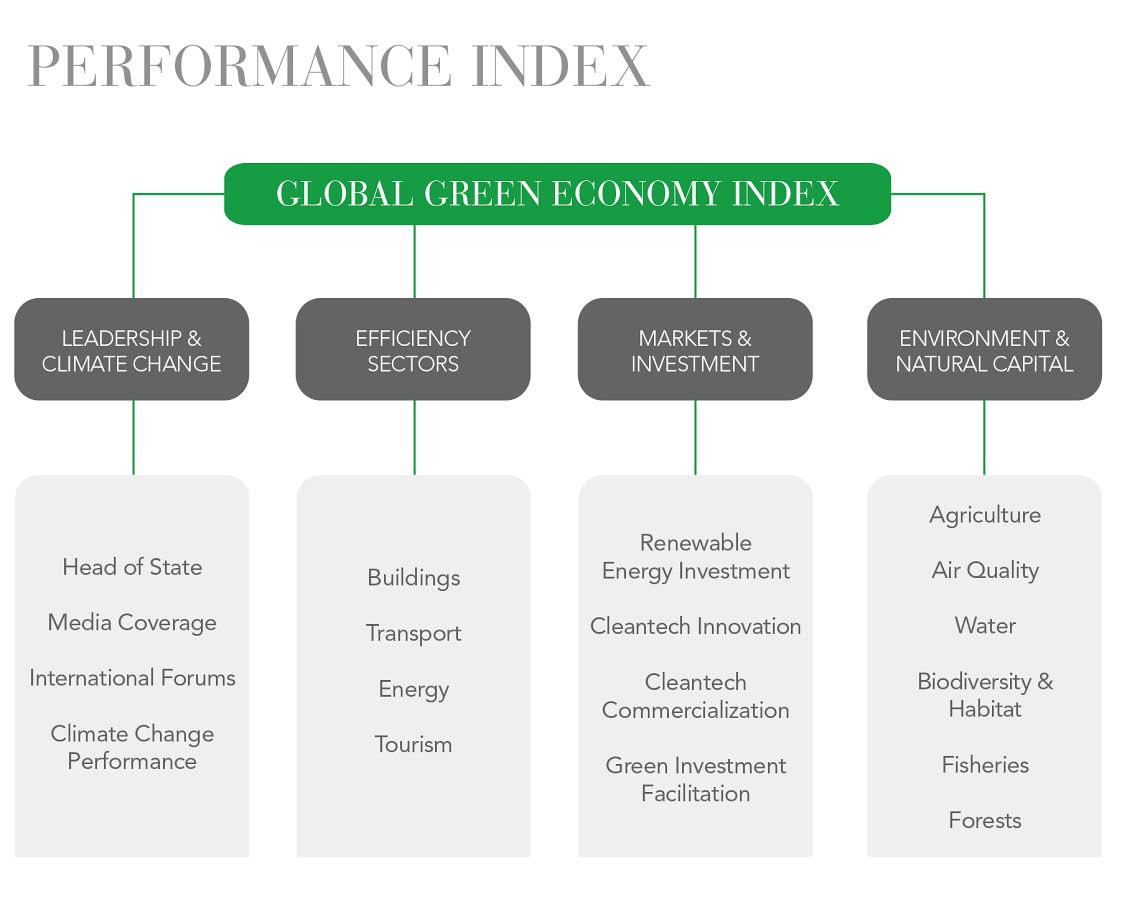A new 4th edition of the Global Green Economy Index (GGEI) calculates the green economic performance of sixty countries, as well as how global practitioners assess it. The GGEI computes these values on the following four dimensions: leadership & climate change, efficiency sectors, markets & investment, and environment & natural capital. Thirty-two underlying indicators and datasets define the GGEI performance index; a survey conducted between June and August of 2014 captures practitioner perceptions with over 1,000 responses.
Global indices like the GGEI are useful in providing one standard benchmark against which policymakers can track their absolute and relative performance in the green economy over time. By measuring each country according to the same topics and themes – while referencing universally applicable indicators and datasets – the GGEI generates a reference point to understand how one country’s green economic performance compares to another, and insight into reasons for superior or inferior results.

Importantly, the GGEI also captures perceptions of the same values measured in the performance index. These gaps between perception and performance in the green economy are important to understand. They reveal whether political rhetoric and policies impact actual performance. They also show where better communications and information exchange are required. For example, the GGEI finds that many attractive markets for green investments and cleantech innovation are not perceived as such by the experts polled in the survey – a clear case requiring better strategic communications.

Some of the highlighted results from this new edition of the GGEI:
- Germany (perception) and Sweden (performance) top the 2014 GGEI, confirming a trend observed in prior editions of strong results by Germany and the Nordic states. Besides performing well on both the economic and environmental areas of the GGEI, these nations display consistent green leadership and receive global recognition for it.
- Covered for the first time in this edition, Costa Rica performs extremely well, ranking third on the GGEI performance measure behind Sweden and Norway and receiving strong recognition on the perception survey, an impressive result for such a small country.
- Many of the fastest growing economies in the world rank poorly on the GGEI performance measure, highlighting an urgent need to reorient their economies to greener growth pathways. Regionally, these countries are mostly in Africa (Ghana), the Gulf (Qatar, United Arab Emirates), and Asia (Cambodia, China, Thailand, Vietnam).
- There are concerning results related to more developed countries as well – notably Australia, Japan, the Netherlands, and the United States – where perceptions of their green economic performance dramatically exceed their actual performance on the GGEI. These countries appear to receive more credit than they deserve, an information gap that requires further exploration.
- Five European nations - Austria, Iceland, Ireland, Portugal and Spain – reveal performance scores that exceed their perception ones significantly – signaling an urgent need for better strategic communications and information exchange of their green merits and associated investment opportunities.
- The GGEI results reveal a similar observation for a variety of non-European states - including Ethiopia, Mauritius, Rwanda and Zambia in Africa and Colombia, Chile and Peru in Latin America – again suggesting a need for these states to better position their green economies on the international stage.
Being a global index, the GGEI is built to look at the sixty countries it covers through one established framework with indicators, datasets and an underlying methodology to support it. However, the pathways to green economic growth differ greatly between countries, regions and cities. Thus, leaders can use data and learning from the GGEI as a starting point to customizations that more accurately reflect nuanced economic, environmental and social characteristics. These customizations may exclude certain sectors that are not as relevant to the market in question. Or, they may use national, regional or city-level data (rather than the primarily international sources defining the main GGEI) and incorporate planned interventions derived from government-authored development plans.
There are also ways that the perception component of the GGEI can be customized to more specific national, regional or city contexts. One example relates to green branding, and the process through which places position themselves around one or more aspects of green economy. For example, what story can you tell through communications if leadership and policy are perceived as good, but not investment opportunities? Or what if there is a sense that the nation or city is a strong target for investment but that the underlying policies are inconsistent? What if national or city commitments to the environment are applauded in an emerging economy, but rapidly growing efficiency sectors are viewed as resource inefficient?
Another way the perception component of the GGEI can be customized is through localized perception surveys. The perception survey for the GGEI is global, and polls practitioners working internationally on their assessments of green economic performance. But while global perceptions are critical, local ones sometimes matter most for the immediate decisions faced by governments and private actors. Localized perception surveys draw upon the methodology behind the global GGEI perception survey, but tailor this approach to more localized contexts. One valuable localized perception survey might be to poll potential customers in a given country about their demand for products or services offered by a business considering investment or joint partnership. Another example could be a national ministry surveying segments of its constituents to better understand if citizens associate positive outcomes with recently adopted green economy policies.
The GGEI performance index incorporates data from other global indices, including the Climate Change Performance Index (Germanwatch), the Global Cleantech Innovation Index (WWF, Cleantech Group), the Global Innovation Index (INSEAD, World Intellectual Property Organization) and the Environmental Performance Index (Yale University). By integrating these other indices, the GGEI offers policymakers perception values for the topics they measure. The GGEI also provides one perspective on how the topics they cover operate in a framework designed to measure national performance in the global green economy.
To download the new 2014 Global Green Economy Index, please click here.
